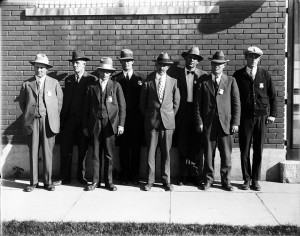Chief Howard Gillette
In 1936, Howard Gillette was appointed Chief of Police to what has been described as a very corrupt department. Gillette made it known early in his career that he would not tolerate corruption and unethical behavior from his officers. During his tenure, several significant criminal cases occurred and numerous advances were made in the field of policing. Gillette served under numerous mayors and transformed the Department from a dysfunctional organization into one of the premiere law enforcement agencies in the State of Idaho.
The Case of the Murdering Ex-Mayor
Two years after Gillette was appointed the Chief of Police, he learned that a traveling jewelry salesman named George Olsen had been found murdered in his car outside of the old Park Hotel. During the early stages of the investigation, it was learned that the man who had hired Gillette, the former Mayor of Twin Falls, Duncan Johnston, had both a business and personal relationship with the victim.
At that time, Johnston operated a jewelry store on Main Avenue and had frequently purchased jewels from Olsen. Gillette personally led the investigation, and he quickly learned that Johnston was the last person to see Olsen alive, $15,000 worth of jewelry that Olsen had with him was missing, and that Olsen had come to town to collect a substantial amount of money that Johnston owed him.
When it became apparent to investigators that Johnston was being dishonest about his alibi and relation with Olsen, Gillette decided to conduct a covert investigation to find out if Johnston had committed the murder. At 4:00 a.m. on June 2, 1938, Officer Craig Bracken was assigned to sneak into the basement of Johnston’s store and observe the former mayor’s activities. At 9:00 am, Bracken heard Johnston coming down the stairs into the basement. He then observed Johnston remove a piece of the concrete wall, revealing a hiding place. He watched as Johnston took a small piece of folded cloth from inside the wall.
Bracken revealed and identified himself and discovered Olsen’s missing jewels. He then arrested Johnston and brought him to the police station. A later search of Johnston’s store revealed the murder weapon, a .25 automatic Colt pistol, hidden in the basement floor. It was later proven that Johnston owned the gun, despite that fact that he had previously swore to Gillette that it had been sold. Johnston was charged with the murder and was convicted by a jury on December 11, 1938, of first degree murder.
Achievements
Throughout his long service of twenty-five years to the City of Twin Falls, Howard Gillette was known for his love of law and order. He was a stern man and lived by a strict code of ethics. He also expected his police officers to honor that same code of principles. Gillette memorized his expectations to writing and posted them on the wall of his office. His “Requirements of a Police Officer” inspired numerous officers and citizens and reflects a more candid time in our country.
Chief Gillette gained the respect of criminals by providing funds for information and to leave town. He proved time and again that he wanted to take care of his officers and his community. During World War II, Gillette attended the FBI Academy and was called to serve the FBI as an agent for approximately two years. He then returned to Twin Falls as the chief and retired in 1962.
During Gillette’s leadership, several men served on the Department and then went on to serve the citizens of Idaho in leadership roles. One of these men was Patrolman A.E. Perkins, hired approximately 1938, went on to work the Idaho State Police and eventually retiring as that agency’s Superintendent. Another was Officer Wesley Dobbs. Dobbs was hired by the TFPD in 1948 and he temporarily left to serve in the Korean War. He returned in 1951 and served Twin Falls until 1961. He left the TFPD to join the Idaho State Police, and in 1965 created and managed the Law Enforcement Training at the College of Southern Idaho for over 30 years.
Dobbs states that during his career with the Twin Falls Police, several unique stories come to mind. One is the way the officers were summoned for calls. Several call lights were place on the corners and on top of buildings. If the desk person wanted you for a call, a light would come on and you would “respond to the light” by calling the desk sergeant via a phone or call box, or by reporting directly to the station. Retired Captain Kenny Johnston, who served from 1945 to 1979, remembers when there was only one radio available to talk to the dispatcher. He relied upon the eight other officers for backup and having telephones nearby.
Read more of the history of the Twin Falls Police Department
